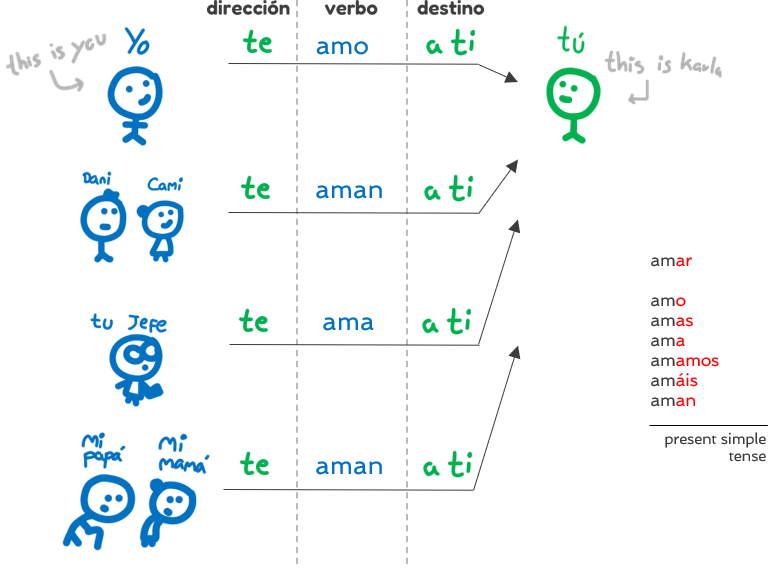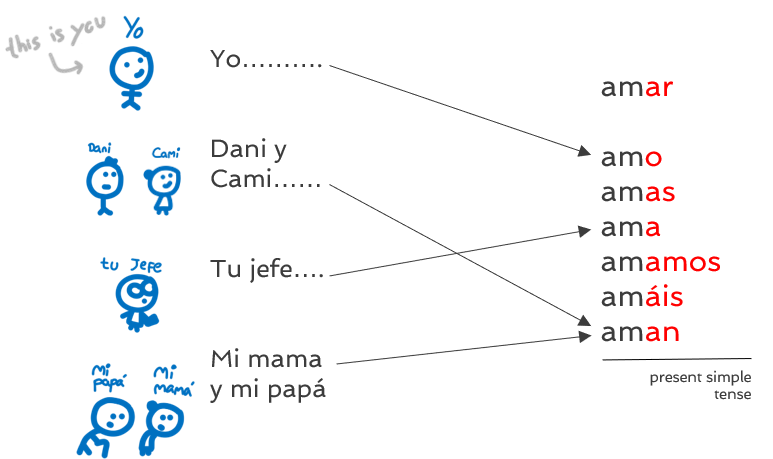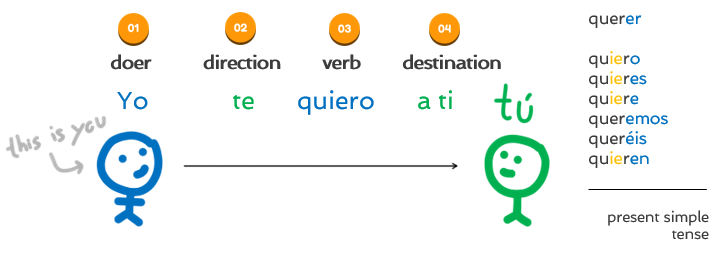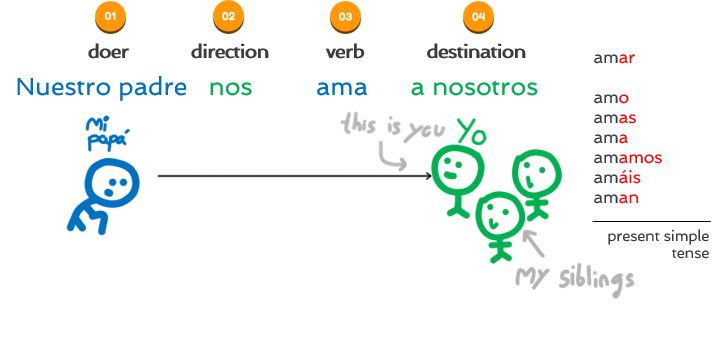Indirect object examples – ‘te’ and ‘a ti’
Present simple tense – affirmative examples
1. I listen to you carefully.
Yo te escucho a ti cuidadosamente
Or simply: Yo te escucho cuidadosamente
2. She is calling you right now.
Ella te está llamando a ti en este momento
Or simply: Ella te está llamando en este momento
3. We help you with your homework.
Nosotros te ayudamos a ti con tus tareas
Or simply: Nosotros te ayudamos con tus tareas
4. He is waiting for you at the door.
Él te está esperando a ti en la puerta
Or simply: Él te está esperando en la puerta
5. I understand you perfectly.
Yo te entiendo a ti perfectamente
Or simply: Te entiendo perfectamente
6. Your friends value you a lot.
Tus amigos te valoran a ti demasiado
Or simply: Tus amigos te valoran demasiado
7. My brother lends you his books.
Mi hermano te presta a ti sus libros
Or simply: Mi hermano te presta sus libros
8. The teacher explains everything to you patiently.
La profesora te explica a ti todo muy pacientemente.
Or simply: La profesora te explica todo muy pacientemente.
9. I’m inviting you to the movies this Friday.
Yo te estoy invitando a ti al cine este viernes
Or simply: Te estoy invitando al cine este viernes
10. Your grandma makes you breakfast every day.
Tu abuela te hace el desayuno a ti todos los días
Or simply: Tu abuela te hace el desayuno todos los días
What is the point of a ti ?
Referring back to example 9, “I’m inviting you to the movies this Friday”, imagine the guy you like is telling you he’d rather go out with you than with Rebecca.
🔹He says: “I don’t want to go to the movies with Rebecca because I don’t like her. That’s why I’m inviting you to the movies this Friday.”
🔹He says: No quiero ir a cine con Rebecca porque ella no me gusta. Por eso te estoy invitando al cine este viernes a ti.
In this case, he’s expressing contrast—between someone he doesn’t want to go out with and you.
Using a ti isn’t mandatory, but it reinforces his interest and makes the contrast more personal and clear.


Still stuck in translator mode when speaking Spanish? Time to upgrade!
Our brand new course is here to help you use pronouns like me, te, nos, le, les, lo, and la with confidence — and sound way more fluent.
Present simple tense – negative examples
1. I don’t understand you when you speak so fast.
Yo no te entiendo a ti cuando hablas tan rápido
Or simply: No te entiendo cuando hablas tan rápido
2. My friends don’t call you on the weekends.
Mis amigos no te llaman a ti los fines de semana
Or simply: Mis amigos no te llaman los fines de semana
3. I´m not giving you any advice unless you ask me.
Yo no te voy a dar ningún consejo a ti a menos que me preguntes
Or simply: Yo no te voy a dar ningún consejo a menos que me preguntes
4. Your siblings don’t help you with the chores.
Tus hermanos no te ayudan a ti con el oficio de la casa
Or simply: Tus hermanos no te ayudan con el oficio de la casa
5. Your boss doesn’t respect you as he should.
Tu jefe no te respeta a ti como debería
Or simply: Tu jefe no te respeta como debería
6. We don’t see you very often.
Nosotros no te vemos a ti tan seguido.
Or simply: No te vemos tan seguido.
7. Noise at night doesn’t bother you.
El ruido de la noche no te molesta a ti
Or simply: El ruido de la noche no te molesta
8. I don’t look for you because you’re always busy.
Yo no te busco a ti porque siempre estás ocupado.
Or simply: No te busco porque siempre estás ocupado.
9. I don’t text you every day, but I’m always thinking of you.
Yo no te escribo a ti todos los días, pero yo siempre te estoy pensando a ti
Or simply: No te escribo a ti todos los días, pero siempre te estoy pensando
10. Your daughter doesn’t understand you well.
Mi hermana no te entiende bien a ti
Or simply: Mi hermana no te entiende bien
Present simple tense – question examples
1. Do your friends call you often?
¿Tus amigos te llaman a ti seguido?
Or simply: ¿Tus amigos te llaman seguido?
2. Do they understand you well in class?
¿Ellos te entienden a ti bien en clase?
Or simply: ¿Ellos te entienden bien en clase?
3. Does noise bother you?
¿El ruido te molesta a ti?
Or simply: ¿El ruido te molesta?
4. Does your boss text you on weekends?
¿Tu jefe te escribe a ti los fines de semana?
Or simply: ¿Tu jefe te escribe los fines de semana?
5. Does your brother help you with homework?
¿Tu hermano te ayuda a ti con las tareas?
Or simply: ¿Tu hermano te ayuda con las tareas?
6. Does your teacher pay attention to you?
¿Tu profesor te presta atención a ti?
Or simply: ¿Tu profesor te presta atención?
7. Does your family visit you on Sundays?
¿Tu familia te visita los domingos a ti?
Or simply: ¿Tu familia te visita los domingos?
8. Does Juan always greet you when he sees you?
¿Juan siempre te saluda a ti cuando te ve a ti?
Or simply: ¿Juan siempre te saluda cuando te ve?
9. Do they call you by your nickname at work?
¿Ellos te llaman por tu apodo a ti en el trabajo?
Or simply: ¿Ellos te llaman por tu apodo en el trabajo?
10. Does your cat look for you when you get home?
¿Tu gato te busca a ti cuando llegas a tu casa?
Or simply: ¿Tu gato te busca cuando llegas a tu casa

🎯 Want to use Spanish object pronouns like a true native speaker?
At Spanish4dinner, we’ve got you covered when it comes to mastering Spanish pronouns.

Grab your free 100 phrases you’re saying wrong 100 days to get them right eBook and start building a habit that will make your Spanish sound more natural—just like a local!























































